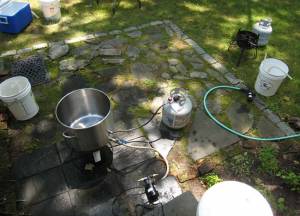As I’ve progressed as a homebrewer, I’ve spent a lot of time trying new techniques and tweaking my process. Here are the five changes I’ve made which have had the greatest impact on the quality of the beer I brew.
1. Controlling fermentation temperatures
This is the single most important thing I can recommend to new homebrewers, since it is often overlooked in the beginning and will make an enormous difference in every beer you brew. The first beer I made was fermented in an 80°F ambient room with a brewbelt on the fermentor. It was an awesome beer because I made it, but I don’t think I’d much enjoy a bottle of that today. Fermenting hot can cause all kinds of off flavors and nasty fusel alcohols in the finished product. Fermentation temperatures, with few exceptions, are best kept in the low to mid 60s for ales and even cooler for lagers. A cheap mini-fridge (I got mine on craigslist for $100) and a temperature controller turned my beers from OK to delicious.
2. Pitching the correct amount of yeast
This is another technique that can help all of your beers – extract, partial mash, or all grain. Controlling fermentation is paramount to brewing, and pitching the proper amount of healthy yeast is a big part of that. For every beer you brew, you should be going to Jamil Zainasheff’s Pitching Rate Calculator and figuring out the correct amount of starter, dry yeast, or slurry you should be pitching. If you are using liquid yeast, do yourself a favor and learn how to make a yeast starter (I will have a step-by-step tutorial with pictures posted here soon). Your beer will return the love.
3. Switching to full boils
When I started out, I was constrained to doing partial boils of extract recipes. The size of my brewpot, stove, and apartment dictated the maximum amount of wort I could safely boil at one time. This is a great way to get started in the hobby – you can start off on your household stove, you don’t need a huge kettle, and the boil and cooling phases of the brew are quicker and easier. However, I definitely saw a big difference in quality when I was able to move to full boils. Not only did it prepare me for the leap to all grain, but it produced a better beer – it is almost impossible to produce a light-colored beer with a partial boil due to the concentration of the wort, and full boils allow for proper hop utilization. Even if you never switch to all grain, make the switch to full boils if your circumstances allow.
4a. Switching to all grain
Ahh, the Holy Grail of brewing. Many homebrewers will never attempt all grain – for some it is more trouble than it’s worth, while others may not have the space, time, or money to make the switch. That’s fine – you can make excellent beers using extract, and the many varieties of extract available today gives you a lot of flexibility to brew different styles. However, if you want total, complete control of the brewing process from start to finish, all grain is a must. It’s really not that difficult once you get the hang of it, and, personally, I feel more invested in a beer that I created out of actual grain. My all grain beers taste much better than my first extract brews, but I wouldn’t blame the extract. Rather, switching to all grain forced me to really learn about beer and become a better brewer. All grain may not be for everyone, but I highly recommend it!
4b. Switching to mini-mashes
Even if you never make the switch from extract brewing, learn to do a mini-mash so you can take advantage of the many specialty grains available to you. My first all-extract beers were lacking in depth and flavor. As soon as I started making some mini-mash kits out there, I saw what a difference specialty grain made in the taste of my beer. Mini-mashes are easy and you get a lot of bang for your buck – just be warned, it’s a slippery slope down to all grain!
5. Kegging my beer
Kegging didn’t directly improve my beer, but it has been one of the biggest improvements to my brewery. Aside from the benefit of having cold, tasty homebrew on tap at a moment’s notice, kegging eliminates my least-favorite part of brewing: bottling. I’ve cut my bottling day time down to thirty minutes, and eliminating this tedious chore has led to increased brewery output and brewer happiness. Also, corny kegs make great vessels for lagering or conditioning, and being able to transfer beer under CO2 pressure helps reduce oxygenation concerns during racking.
